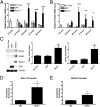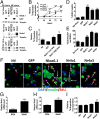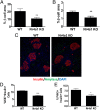Nkx6.1 regulates islet β-cell proliferation via Nr4a1 and Nr4a3 nuclear receptors
- PMID: 24706823
- PMCID: PMC3986138
- DOI: 10.1073/pnas.1320953111
Nkx6.1 regulates islet β-cell proliferation via Nr4a1 and Nr4a3 nuclear receptors
Abstract
Loss of functional β-cell mass is a hallmark of type 1 and type 2 diabetes, and methods for restoring these cells are needed. We have previously reported that overexpression of the homeodomain transcription factor NK6 homeobox 1 (Nkx6.1) in rat pancreatic islets induces β-cell proliferation and enhances glucose-stimulated insulin secretion, but the pathway by which Nkx6.1 activates β-cell expansion has not been defined. Here, we demonstrate that Nkx6.1 induces expression of the nuclear receptor subfamily 4, group A, members 1 and 3 (Nr4a1 and Nr4a3) orphan nuclear receptors, and that these factors are both necessary and sufficient for Nkx6.1-mediated β-cell proliferation. Consistent with this finding, global knockout of Nr4a1 results in a decrease in β-cell area in neonatal and young mice. Overexpression of Nkx6.1 and the Nr4a receptors results in increased expression of key cell cycle inducers E2F transcription factor 1 and cyclin E1. Furthermore, Nkx6.1 and Nr4a receptors induce components of the anaphase-promoting complex, including ubiquitin-conjugating enzyme E2C, resulting in degradation of the cell cycle inhibitor p21. These studies identify a unique bipartite pathway for activation of β-cell proliferation, suggesting several unique targets for expansion of functional β-cell mass.
Conflict of interest statement
The authors declare no conflict of interest.
Figures






References
-
- Weir GC, Bonner-Weir S. Five stages of evolving beta-cell dysfunction during progression to diabetes. Diabetes. 2004;53(Suppl 3):S16–S21. - PubMed
-
- Muoio DM, Newgard CB. Mechanisms of disease: Molecular and metabolic mechanisms of insulin resistance and beta-cell failure in type 2 diabetes. Nat Rev Mol Cell Biol. 2008;9(3):193–205. - PubMed
-
- Sander M, et al. Homeobox gene Nkx6.1 lies downstream of Nkx2.2 in the major pathway of beta-cell formation in the pancreas. Development. 2000;127(24):5533–5540. - PubMed
Publication types
MeSH terms
Substances
Associated data
- Actions
Grants and funding
LinkOut - more resources
Full Text Sources
Other Literature Sources
Molecular Biology Databases
Research Materials

